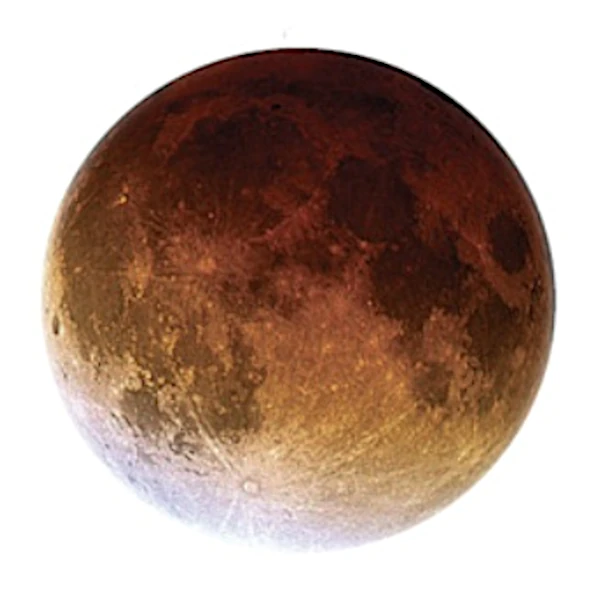
A lunar eclipse occurs when the Earth positions itself exactly between the Sun and the Moon, so that the Earth's shadow cone intercepts the Moon's path. This phenomenon is only possible when the three celestial bodies are perfectly aligned on the ecliptic plane, i.e., during a full Moon. The red Moon or blood Moon results from a combined effect of geometry and optics: although the Moon is immersed in the Earth's shadow, it remains faintly illuminated by sunlight that is refracted and scattered through the Earth's atmosphere.
This light is not white but reddish, because red rays, with their longer wavelengths, are less deviated and less absorbed by Rayleigh scattering. Blue and violet photons, strongly scattered in all directions, are mostly lost before reaching the Moon. Thus, only the red-orange component of sunlight passes through the atmospheric layers at a low angle, forming a luminous halo around the Earth that illuminates the lunar surface.
The observed hue strongly depends on the Earth's atmospheric conditions at the time of the eclipse. An atmosphere loaded with volcanic particles, desert dust, or anthropogenic pollutants enhances the absorption of short wavelengths and intensifies the dark red coloration, sometimes to a deep brown. Conversely, a clear and dry atmosphere results in a brighter Moon with orange tones. Atmospheric transparency can be estimated using the Danjon scale, an empirical scale ranging from L = 0 (invisible Moon, completely dark) to L = 4 (bright, coppery, and clearly visible Moon).
Since antiquity, the blood Moon has fascinated civilizations: in many cultures, it was seen as an omen of extraordinary events. The Babylonians saw it as a royal sign, while the Chinese interpreted its red hue as a cosmic imbalance. Today, this phenomenon is understood through atmospheric physics and celestial mechanics, but it retains its aesthetic and symbolic power.
During a total eclipse, sunlight undergoes several physical processes before reaching the Moon: refraction in the Earth's atmosphere, absorption by aerosols, and selective scattering of short wavelengths. The light spectrum reaching the lunar surface is therefore dominated by red and orange components, explaining the appearance known as the blood Moon. The exact shade depends on the distribution of particles and the density profile of the atmosphere traversed by the solar rays tangential to the Earth.
Partial eclipses do not always exhibit this phenomenon because only part of the Moon enters the Earth's shadow. The portion remaining in the penumbra retains a silvery glow due to direct sunlight. These differences in brightness and hue allow the study of the Earth's shadow cone structure and indirectly assess the clarity of the atmosphere on a planetary scale.
| Characteristic | Typical Value | Comment |
|---|---|---|
| Hue | Red to brownish | Varies depending on the concentration of dust and ash in the atmosphere |
| Duration of a total eclipse | ~1 to 2 minutes | Time during which the Moon completely passes through the Earth's shadow |
| Lunar phase | Full Moon | A total lunar eclipse can only occur during a full Moon |
| Solar incidence angle | Variable | Influences the distribution of refracted light on the lunar surface |
Sources: Espenak & Meeus, 2006; NASA Eclipse Web Site; Scientific literature on atmospheric scattering.